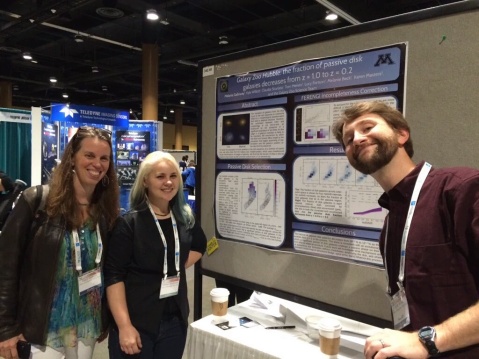Galaxy Zoo at the 227th AAS meeting
We posted briefly about the 227th meeting of the American Astronomical Society, which several members of the Galaxy Zoo science team attended last week. I wanted to share a little bit more about the research that we presented, and the experiences we had at the meeting.

Asst. Prof Lucy Fortson, PhD student Melanie Galloway, and postdoc Kyle Willett (Univ. of Minnesota) at an evening poster session at the 227th AAS meeting.
Kyle Willett (Postdoc, University of Minnesota)
I presented a poster on the data release of the Galaxy Zoo: Hubble project. While it’s been a couple of years since we formally finished the classifications for GZH, we’ve been working hard in the meantime on aggregating and calibrating the data; this includes two supplementary data sets that users helped classify in the newest interface. One of those sets were the images of galaxies processed with the FERENGI code in order to mimic their appearances at higher redshifts; these have been absolutely critical for the calibration/debiasing procedure we’re applying to the real Hubble galaxies. The second set of new images were the deeper images of galaxies in the GOODS north and south fields, completed early last year. We’re using these to analyze the effect of depth on morphologies, and seeing how the disk/clumpy fractions change with improved imaging.
AAS went well for me, and I got to talk about GZH with a number of new colleagues. I particularly liked having my poster between Melanie Galloway’s and Brooke Simmons’ — I got to point out GZH science results on one side and the next generation of even higher redshift galaxies on the other, which made for a very nice story to tell.
Melanie Galloway (PhD student, University of Minnesota)
Galaxy Zoo users probably know that there are two main types of galaxies: disks and ellipticals. There is a cool relationship between these shapes and their color: disks tend to be blue (which is an indicator of young stars), while almost all ellipticals appear red (which indicates the stars are old; “red and dead” is a term commonly used.) Astronomers believe that this relationship between color and shape implies that galaxies tend to be created as disks, and over their lifetimes, transform from young disks to old ellipticals. Data from Galaxy Zoo revealed that there are also red disk galaxies in the Universe, and right now it is not known how they fit into our current perception of galaxy evolution.
Mel used data from Galaxy Zoo: Hubble to tackle this question by analyzing how the fraction of red disks changed between now and 6 billion years ago. She found that this fraction was actually much higher in the past! This result probably means that red disks don’t tend to stay red disks, and may instead be a common phase of a typical galaxy’s evolution from blue disk to red elliptical.
Melanie Beck (PhD student, University of Minnesota)
At this year’s AAS conference, I presented work which focused on the relationship between galaxies’ masses and their sizes. In general, more massive galaxies are also physically larger (but not always!). However, the mass-size relationship is different for galaxies in the distant universe compared to those in the nearby universe. It’s also different between disk galaxies compared to ellipticals in that the sizes of elliptical galaxies grow much, much faster than those of disk galaxies but don’t seem to grow much in mass. To explain this behavior, models predict that disk galaxies must evolve into elliptical galaxies at a rate that mimics the growth rate of the ellipticals. These models predict that there should be many more elliptical galaxies of a particular size and mass in the nearby universe compared to disks. To test this, we need to keep track of the number of galaxies as a function of mass, size, and type (elliptical or disk) over a large period of time.
My initial work utilizes classifications from Galaxy Zoo 2 separated by Smooth or Features/Disk. All the galaxies in this catalog are considered to be in the local universe. Using sophisticated statistical techniques, I’m able to robustly determine the number of galaxies as a function of mass, size and type. Next I’m applying the same techniques to classifications from Galaxy Zoo: Hubble and Galaxy Zoo: CANDELS as these catalogs contain galaxies from the more and more distant universe. Once we have the analysis from all three we can compare the numbers of galaxies at each time and finally test those models!

Melanie Beck discussing her poster with Prof. Chris Conselice (Univ. of Nottingham).
Brooke Simmons (Postdoc and Einstein Fellow, UC San Diego)
AAS is always a hectic science bonanza, and presenting a poster is a way of slowing things down a bit: unlike a talk, which is over in 15 minutes or less, you get to have your results up all day. My poster was an introduction to the upcoming release of classifications for the high-redshift CANDELS galaxies, so it shows a basic overview of how the classifications work and an early science result about featureless disks at high redshift.
It was great to present 2 data releases side-by-side, with Kyle’s poster to my left, and it was even better to get to present the result of the volunteers’ efforts. Between these posters and the previous data releases for Galaxy Zoo, we’ve measured the shapes of hundreds of thousands of galaxies (actually, I think it’s over a million!) spanning the last 12 billion years of cosmic time.





Trackbacks / Pingbacks